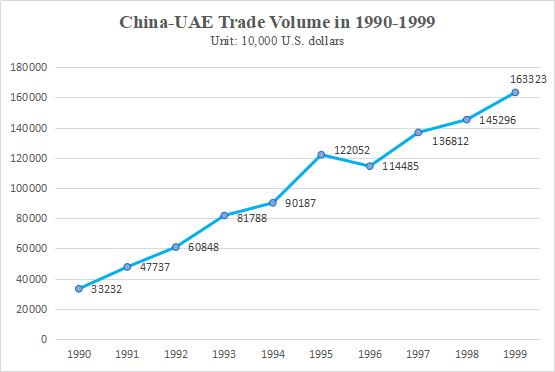Since the 1950s, there has been civil trade between China and the UAE. In 1984, the two countries established diplomatic ties, laying a cornerstone for their trade and economic cooperation. In 1985, China and the UAE signed the Agreement on Economic, Trade and Technical Cooperation between the Government of the People's Republic of China and the Government of the United Arab Emirates. In the same year, the bilateral trade volume registered 63 million U.S. dollars. Since then, the trade volume has been on the rise. From the establishment of strategic partnership in 2012 to the establishment of comprehensive strategic partnership in 2018, China-UAE bilateral relations have shown a trend of upward and fast development. The smooth bilateral relations have boosted economic development in the two countries. In return, the sound economic and trade ties have solidified the base of bilateral relations. According to available historical data, since 1990, China-UAE trade and economic cooperation can be classified into the following three stages.
(I) 1990-1999: Slow Growth
In May 1990, then UAE President Sheikh Zayed bin Sultan Al Nahyan visited China. It was the first visit to China paid by a state leader of GCC countries, marking fast development of bilateral relations in politics, economy, culture, and other fields. With the rapid development of China's economy and import-export and its import of oil from the UAE, in 1995, China-UAE trade volume reached 1.22 billion U.S. dollars, the first time that the bilateral trade volume has exceeded 1 billion U.S. dollars.

Source: National Bureau of Statistics of China
According to data of the National Bureau of Statistics of China, in 1990-1999, the total trade volume between China and the UAE reached nearly 10 billion U.S. dollars, with an average annual increase rate of about 20 percent. During this period, China mainly exported textiles, home appliances, mechanical equipment, and raw materials to the UAE and imported oil and aluminium ingot from the UAE. In UAE, a host of trading centers have been built, such as Ajiman Chinese products trading center (CPTC, not the current Ajman China Mall), Sharjah China electrical and mechanical exhibition center, Global Village (Dubai), and Murshid Bazaar market. In early years, most Chinese in trading market were sent there for external assignment. Those of state-owned enterprises mainly traded in Dubai and Abu Dhabi, and private trade mainly happened in Sharjah, Ajman and Dubai.
It is worth mentioning that despite the huge oil dollar income, back then, the UAE had not improved its infrastructure, which meant opportunities for China's engineering and construction companies. From 1982, China's construction contracting companies, such as China Civil Engineering Construction Corporation (CCECC), China Harbour Engineering (Group) Company, and China National Aero-Technology Import & Export Corporation, started to establish subsidiaries in Abu Dhabi, the UAE and contract flyovers, roads, houses, schools, and other projects. However, generally speaking, because of technical and labor limitations, during that period, projects contracted by Chinese companies in the UAE proceeded slowly.
During that period, the slow growth of China-UAE trade was caused by the following factors: the first was the simple trade structure, which was dominated by trade in goods like textiles, light industrial goods, mechanical and electrical products, and other goods, with little project contracting and labor cooperation, and cooperation in establishment of joint venture. The second was the fierce competition in the UAE. Besides competitors from the US, Japan, India and other countries, Chinese enterprises also wanted to sell their goods via Dubai to other Gulf States and North Africa, causing unplanned export. As a result, Chinese goods were oversupplied and unmarketable. As manufacturers scrambled to cut prices, disordered competition happened. Third, in early years, most Chinese products on offer were of low and middle-grade, earning profits with low prices, hence leaving the image of "poor quality and low price" in the Middle East market. That was an unfavorable factor for China to expand market in the UAE and the Middle East. It also meant that such a trade mode was unstable and unsustainable. Fourth, since 1995, China started to import oil from the UAE and the export to the UAE accounted for a small share in total bilateral trade volume.




 A single purchase
A single purchase








